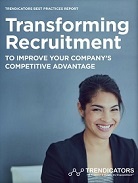
Why employee recognition matters and how to effectively deliver it.
In my two previous columns (Creating a Great Employee Experience and Why RESPECT Matters), I introduced the RESPECT taxonomy of what employees most want from their employer and shared research revealing the customer loyalty and financial gains to organizations for delivering RESPECT (Recognition, Exciting Work, Security, Pay, Education and Career Growth, Conditions, and Truth).
Let’s take a deeper dive into each of the seven attributes of the RESPECT model, starting with the “R” for employee recognition in this column.
RECOGNIZE ALL EMPLOYEES
Research consistently indicates that employees want and need recognition for their hard work. Being appreciated by an organization and its leaders is crucial to employees feeling good about their work, but it is also essential to forming loyalty to an organization and being productive. All employees want to be recognized.
Employees often feel recognition is reserved for only the most productive employees. This turns out to be a fundamental oversight at many organizations. Recent research in the U.S. reveals that only 72 percent of employees feel recognized by their managers for their good work, and only 64 percent feel they work for an organization that values their contribution. That leaves more than one-quarter and more than one-third of employees, respectively, having unmet recognition needs. Not only is recognition a low-cost technique to engage employees in their work, it also translates directly into stronger employee performance.
The role of the manager is critical in doling out praise. In fact, how employees view their manager’s overall performance is influenced by how managers use recognition. Those who are satisfied with the recognition they receive perceive their managers much more favorably than the under-recognized. But it is also true that when recognition comes from higher levels in the organization, it has the most significant impact. Netnet: It is important that managers at all levels of the organization learn to recognize employees properly.
HOW TO RECOGNIZE
Entire books are dedicated to how, when, and under what circumstances to deliver employee recognition. Here are some fundamentals:
- Timeliness: The shorter the interval between an individual’s action and the corresponding recognition, the more powerful the impact.
- Specificity: Recognition that focuses on a specific behavior or performance will be viewed as the most useful by employees.
- Frequency: Recognize often and regularly.
- Fairness and accuracy: When recognition pertains to performance that is verifiable and comes from a respected source, it is more meaningful.
- Helpfulness: For best results, recognition must not only identify the positive outcome but also explain how the employee’s action led to it.
IMPROVING RECOGNITION
Here are seven proven methods for improving the delivery of employee recognition:
1. Identify employee preferences. Get to know your employees to understand what they like and don’t like. For example, some love public recognition, while others prefer to be recognized privately.
2. Make informal recognition a habit. Employees often tell me the recognition they most want is to be told, “Thank you” or “Good job.”
3. Communicate success. When face-to-face communication is not possible, use e-mail, text messages, and voicemail. Timeliness is key.
4. Establish criteria and clear policies for “formal” recognition programs. Everyone should be playing by the same rules.
5. Create opportunities for contact with higher-level managers. This is a powerful form of strategic recognition.
6. Train managers in recognition practices and techniques. As with any skill, training and practice are essential components for success.
7. Use training opportunities as a form of recognition. This has double value: Employees get recognized, and develop the skills needed for career growth.
Simply put, recognized employees work harder, perform better, and stay longer.
This article originally appeared in Training Magazine.
 Jack Wiley, Ph.D. is an award-winning organizational psychologist, researcher, and leadership consultant. He is the author of three books, The Employee-Centric Manager: 8 Keys to People-Management Effectiveness (2021), RESPECT: Delivering Results by Giving Employees What They Really Want (2012), and Strategic Employee Surveys: Evidence-Based Guidelines for Driving Organizational Success (2010). Dr. Wiley is president and CEO of both Employee Centricity LLC and Jack Wiley Consulting, LLC, and the Chief Scientific Officer at Engage2Excel.
Jack Wiley, Ph.D. is an award-winning organizational psychologist, researcher, and leadership consultant. He is the author of three books, The Employee-Centric Manager: 8 Keys to People-Management Effectiveness (2021), RESPECT: Delivering Results by Giving Employees What They Really Want (2012), and Strategic Employee Surveys: Evidence-Based Guidelines for Driving Organizational Success (2010). Dr. Wiley is president and CEO of both Employee Centricity LLC and Jack Wiley Consulting, LLC, and the Chief Scientific Officer at Engage2Excel.
Connect with him on LinkedIn.


